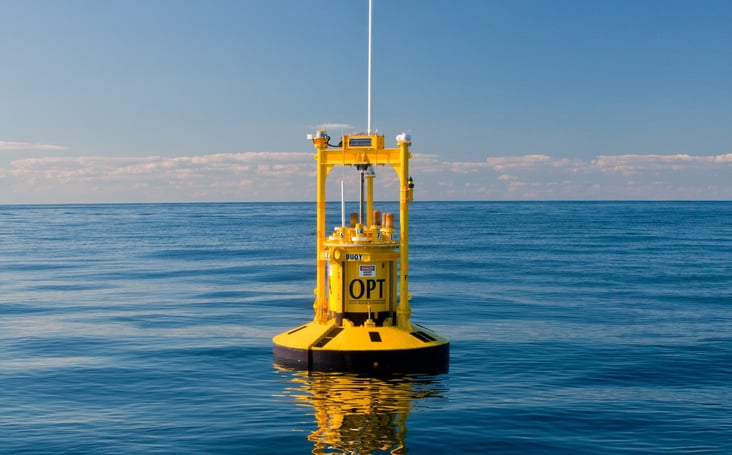This post is one in a series featuring the complete slate of advanced energy technologies outlined in the report This Is Advanced Energy.

Photo courtesy of Ocean Power Technologies.
Marine and hydrokinetic power technologies generate electricity from the kinetic energy of moving water, including waves, currents, and tides. Wave energy devices are designed to capture energy from the rising and falling of waves or their forward movement. For example, the relative motion between a buoy at the surface and a fixed tether on the sea floor can be used to drive a generator. Tidal energy can be captured in two ways. First, in places with the right undersea topography, daily currents created by ocean tides can be used to drive underwater turbines. Similar technology can exploit the constant ow of water in rivers or in large-scale ocean currents like the Gulf Stream. Second, in places with large tidal ranges, tidal barrages (dams or barriers) can be built across bays or estuaries to capture energy from the receding tide via turbines as water ows out to sea. Within each category, there are many different technologies in development, particularly for wave energy capture. Proximity to shore, ocean depth, and expected sea conditions are all major considerations for these technologies. Another type of marine energy, called Ocean Thermal Energy Conversion (OTEC), exploits temperature and/or salinity gradients between surface waters and deeper water to drive various power cycles.
Marine and hydrokinetic power is an emerging technology with great potential. Capturing 0.3% of the energy of the Gulf Stream would be enough to supply all of Florida’s electricity needs. The Department of Energy estimates that the United States has the potential to develop about 50 GW of tidal power alone. At present, marine projects in the United States are principally for demonstration and testing purposes, but there is substantial interest in the technology. As of March 2015, the Federal Energy Regulatory Commission (FERC) had issued eight preliminary permits for 104 MW of electricity, while four pilot projects had received licenses for over 2 MW of capacity. When completed, the world’s first grid-connected tidal project, the Roosevelt Island Tidal Energy (RITE) facility in New York City, will provide 1 MW of electricity.
Although marine and hydrokinetic energy resources are variable, they are very predictable, making grid integration relatively easy. Tides are extremely regular, and even wave conditions can be forecast with reasonable accuracy several days in advance. When complete, the RITE project will generate electricity for about four hours at a time every six hours, following the regular ow of New York’s East River. Furthermore, marine and hydrokinetic power generates this reliable electricity at no fuel cost, offering great potential for cost reductions as the technology develops and the industry scales up production. Along with falling costs, increased deployment will create construction, operation, and maintenance jobs that can bring new economic activity to coastal industries such as ports and shipbuilding.
Read more about the full slate of advanced energy technologies in our report, available for free at the link below:
